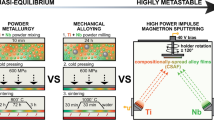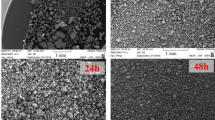Abstract
Atomic-deficient free-volume transformations in directly synthesized β-As4S4 arsenical subjected to nanostructurization due to high-energy speed-increased (0–200–500–600 rpm) milling are comprehensively studied employing lifetime spectroscopy of annihilating positrons. These data testify that nanocrystalline and amorphous forms coexist among milling products, testifying in favor of milling-driven solid-state amorphization due to “shell” kinetic model. The depressing and time-enhancing trend in the detected positron lifetime spectra serves as a direct indication for continuous generation of amorphous phase, accompanied by free-volume evolution of coupled positron- and positronium (Ps) traps obeying x3-x2-CDA (coupling decomposition algorithm). At the stage of quick accumulation of size-reduced non-interacting nanoparticles characteristic of low speed (200 rpm), triple junctions equivalent to bi-/tri-atomic vacancies appear instead of Ps-traps. At higher rotational speed (500 rpm) exemplified by pelletized arsenicals composed of aggregated nanoparticles due to reversibly enhanced adhesion, these traps grow to characteristic sizes of quadruple vacancies and reduced Ps-to-positron trapping conversion occurs in more amorphous environment. In β-As4S4 subjected to milling at the highest speed (600 rpm), where irreversibly agglomerated nanograins dominate, the positron-to-Ps trapping conversion occurs due to elimination of triple junctions between crystallites and appearance of Ps-traps in more crystalline environment.




Similar content being viewed by others
References
Adam JL, Zhang X (2013) Chalcogenide glasses: preparation, properties and applications. Woodhead Publishing, Philadelphia, New Delhi
Baláž P, Sedlák J (2010) Arsenic in cancer treatment: challenges for application of realgar nanoparticles (a minireview). Toxins 2:1568–1581
Baláž P, Achimovičová M, Baláž M et al (2013) Hallmarks of mechanochemistry: from nanoparticles to technology. Chem Soc Rev 42:7571–7637
Baláž P, Baláž M, Achimovičová M, Bujňáková Z, Dutková E (2017a) Chalcogenide mechanochemistry in materials science: insight into synthesis and applications (a review). J Mater Sci 52:11851–11890
Baláž P, Baláž M, Shpotyuk O, Demchenko P, Vlček M, Shopska M, Briančin J, Bujňáková Z, Ya Shpotyuk, Selepová B, Balážová L (2017b) Properties of arsenic sulphide (β-As4S4) modified by mechanical activation. J Mater Sci 52:1747–1758
Balitska V, Ya Shpotyuk, Filipecki J, Shpotyuk O, Iovu M (2011) Post-irradiation relaxation in vitreous arsenic/antimony trisulphides. J Non-Cryst Solids 357:487–489
Boldyreva E (2013) Mechanochemistry of inorganic and organic systems: what is similar, what is different? Chem Soc Rev 42:7719–7738
Bujňáková Z, Shpotyuk O, Sedlak J, Pastorek M, Turianicova E, Baláž P, Ingram A (2014) Physico-chemical and biological properties of arsenic sulfide (As55S45) nanosuspension prepared by milling. Acta Phys Pol A 126:902–906
Bujňáková Z, Baláž P, Makreski P et al (2015) Arsenic sulfide nanoparticles prepared by milling: properties, free-volume characterization, and anti-cancer effects. J Mater Sci 50:1973–1985
Chakraverty S, Mitra S, Mandal K, Nambissan PMG, Chattopadhyay S (2005) Positron annihilation studies of some anomalous features of NiFe2O4 nanocrystals grown in SiO2. Phys Rev B 71:024115-1–024115-8
Eggleton BJ, Luther-Davies B, Richardson K (2011) Chalcogenide photonics. Nat Photonics 5:141–148
Georgiev DG, Boolchand P, Jackson KA (2003) Intrinsic nanoscale phase separation of bulk As2S3 glass. Phil Mag 83:2941–2953
Hautojarvi P, Pollanen L, Vehanen A, Yli-Kauppila J (1983) Vacancies and carbon impurities in & #x03B1;-iron: neutron irradiation. J Nuclear Mater 114:250–259
Hyla M, Filipecki J, Shpotyuk O, Popescu M, Balitska V (2007) Stoichiometric arsenic sulphoselenides as testing probes for positron trapping in chalcogenide glasses. J Optoelectron Adv Mater 9:3177–3181
Ingram A, Golovchak R, Kostrzewa M, Wacke S, Shpotyuk M, Shpotyuk O (2012) Compositional dependences of average positron lifetime in binary As–S/Se glasses. Phys B 407:652–655
Jean YC (1990) Positron annihilation spectroscopy for chemical analysis: a novel probe for microstructural analysis of polymers. Microchem J 42:72–102
Jean YC, Mallon PE, Schrader DM (2003) Principles and application of positron and positronium chemistry. World Sci. Publ. Co., Pte. Ltd., New Jersy
Jensen KO, Salmon PS, Penfold IT, Coleman PG (1994) Microvoids in chalcogenide glasses studied by positron annihilation. J Non-Cryst Solids 170:57–64
Kansy J (1996) Microcomputer program for analysis of positron annihilation lifetime spectra. Nucl Instr Meth Phys Res A 74:235–244
Krause-Rehberg R, Leipner HS (1999) Positron annihilation in semiconductors. Defect studies. Springer, Berlin
Liu M, Kitai AH, Mascher P (1992) Point defects and luminescence centers in zinc oxide and zinc oxide doped with manganese. J Lumin 54:35–42
Mascher P, Dannefaer S, Kerr D (1989) Positron trapping rates and their temperature dependencies in electron-irradiated silicon. Phys Rev B 40:11764–11771
Mitra S, Mandal K, Sinha S, Nambissan PMG, Kumar S (2006) Size and temperature dependent cationic redistribution in NiFe2O4 (SiO2) nanocomposites: positron annihilation and Mössbauer studies. J Phys D Appl Phys 39:4228–4235
Musgraves JD, Carlie N, Petit L, Richardson K, Boudebs G, Choi J, Richardson M (2011) Effect of replacement of As by Ge and Sb on the photo-response under near infrared femtosecond laser irradiation in As-based sulphide glasses. Intern J Appl Glass Sci 2:308–320
Opoczky L (1977) Fine grinding and agglomeration of silicates. Powder Technol 17:1–7
Saarinen K, Hautojarvi P, Corbel C (1998) Positron annihilation spectroscopy of defects in semiconductors. Semiconduct Semimet 51A:210–285
Schwarz RB, Petrich RR, Saw CK (1985) The synthesis of amorphous NiTi alloy powders by mechanical alloying. J Non-Cryst Solids 76:281–302
Shpotyuk O, Filipecki J, Balitska V (2008) Radiation-induced extended free-volume defects in mixed ternary Ge–As/Sb–S glasses studied with PALS technique. J Optoelectron Adv Mater 10:3193–3197
Shpotyuk O, Ingram A, Shpotyuk M, Filipecki J (2014) Prediction of free-volume-type correlations in glassy chalcogenides from positron lifetime measurements. Nucl Instr Meth Phys Res B 338:66–71
Shpotyuk O, Filipecki J, Ingram A, Golovchak R, Vakiv M, Klym H, Balitska V, Shpotyuk M, Kozdras A (2015) Positronics of subnanometer atomistic imperfections in solids as a high-informative structure characterization tool. Nanoscale Res Lett 10:77-1-5
Shpotyuk O, Ingram A, Bujňáková Z, Baláž P, Ya Shpotyuk (2016) Probing sub-atomistic free-volume imperfections in dry-milled nanoarsenicals with PAL spectroscopy. Nanoscale Res Lett 11:10-1-7
Shpotyuk O, Bujňáková Z, Sayagués MJ, Baláž P, Ingram A, Ya Shpotyuk, Demchenko P (2017a) Microstructure characterization of multifunctional As4S4/Fe3O4 nanocomposites prepared by high-energy mechanical milling. Mater Charact 132:303–311
Shpotyuk O, Bujňáková Z, Baláž P, Ingram A, Demchenko P, Kovalskiy A, Vlcek M, Ya Shpotyuk, Cebulski J, Dziedzic A (2017b) Nanostructurization effects in PVP-stabilized tetra-arsenic tetra-sulfide As4S4 nanocomposites. Mater Chem Phys 186:251–260
Tuomisto F, Makkonen I (2013) Defect identification in semiconductors with positron annihilation: experiment and theory. Rev Mod Phys 85:1583–1631
Vijay YK, Wate S, Awasthi DK, Das D, Ghughre S (2000) Ion induced effects in polymers. Indian J Eng Mater Sci 7:375–377
West RN (1973) Positron studies of condensed matter. Adv Phys 22:263–383
Zhao YH, Jin ZH, Lu K (1999) Mechanical-milling-induced amorphization of Se: a crystallite destabilization model. Phil Mag Lett 79:747–754
Acknowledgements
This work was supported by the Slovak Research and Development Agency under the contract no. APVV-14-0103 and Slovak Grant Agency VEGA (project 2/0027/14). The publication contains the results of studies conducted by President’s of Ukraine grant for competitive projects (F70/134-2017) of the State Fund for Fundamental Research.
Author information
Authors and Affiliations
Corresponding author
Ethics declarations
Conflict of interest
On behalf of all authors, the corresponding author states that there is no conflict of interest.
Additional information
Publisher’s Note
Springer Nature remains neutral with regard to jurisdictional claims in published maps and institutional affiliations.
Rights and permissions
About this article
Cite this article
Shpotyuk, O., Ingram, A., Baláž, P. et al. Free volume studies on mechanochemically milled β-As4S4 arsenical employing positron annihilation lifetime spectroscopy. Appl Nanosci 9, 647–656 (2019). https://doi.org/10.1007/s13204-018-0645-8
Received:
Accepted:
Published:
Issue Date:
DOI: https://doi.org/10.1007/s13204-018-0645-8




